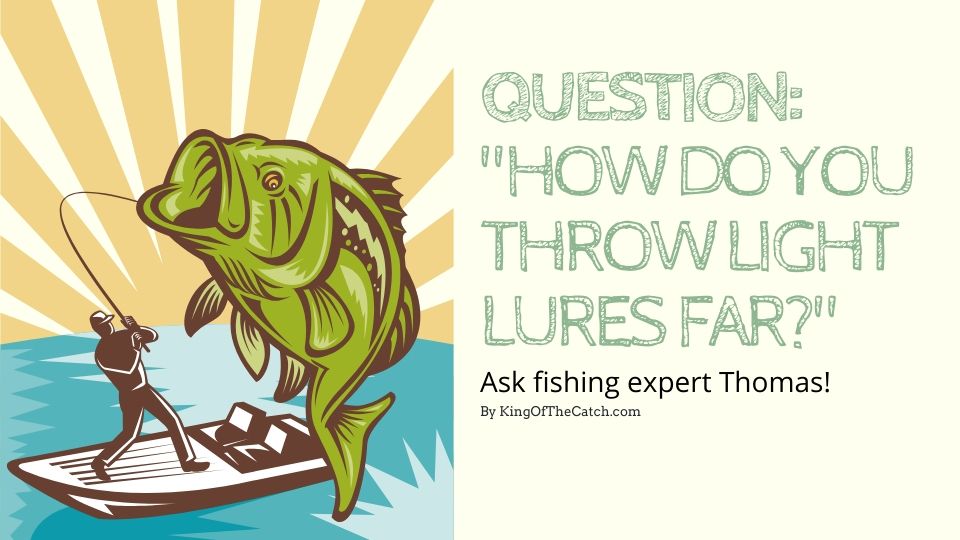Let us imagine a scenario: you have your fishing rod in your hands, the perfect lure for the day, and the weather is on your side. You cast your lure, but it only falls three feet away from you. You try to cast it again with more force thinking it will go further this time.
The light lure refuses to go any further than four feet. Although this is a made-up scenario, I am sure you have gone through such times, just as I have. So now a question arises: is there any way one can cast their light lures further than this measly distance?
How do you throw light lures far?
Question: Hello, my name is Timothy. I am a 38-year-old Ottawan from Canada. I like using light lures for most of my fishing trips, but find it difficult to cast my lines as far as I want. I was wondering if there is anything I can do to increase the throw distance. In short, how do you throw light lures far?
Answer: Hey, Timothy! I am Thomas and here to help you with your question today. I have come across many people who ask the same question about casting light lures. I’ve got some tips and solutions for your problem, and I’m happy to share them with you.
Through this, I will teach you about how you can cast your light lures in such a way that you reach greater distances than before. Not only this, but I will also give you some general tips and tricks to help you throw any lure far.
I want to tell you more about light lures before we discuss this topic’s central issue. Some people prefer lightweight lures because you do not have to make a heavy action to cast it. Taking the example of a light crankbait, you only need to use a light casting action. Many professionals suggest fishers to use light actions as much as possible.
Add lure weights or sinkers
Fishing sinkers are weights that you can add to your lures to make it more substantial. The primary purpose of sinkers is to allow the lure to sink faster, increase its anchoring ability, and, last but not least, make it go further than usual while casting it.
The more weight a lure has, the further it can go when you throw it. There are many types of sinkers that you can choose from in the market. I suggest the Water Gremlin removable split-shot sinkers for an easy and effective weight addition to your lures. These fishing sinkers are easy to attach and easy to remove.
Adding a swivel to your line will help in increasing the weight if you do not want to attach sinkers to your line. One thing you better keep in mind is not to add too much weight. If you do, you will waste a lot of energy and effort on trying to throw a bulky device.
Check the length of the rod
The longer the length of your rod, the greater distance your lure can cover. The best length for your light lure to go as far as possible is a 7-foot or 6-foot rod. There are longer rods than this, but for lightweight lures, it is easier to manage the casting movement on slightly shorter rods. The spinning fishing rod by Ugly Stik will go perfectly with a 1/8 ounce lure.
If you add some weight to your lightweight lure, going for an 8-foot fishing rod is the way to go. You will be able to reach a substantial distance with this length. The best 8-foot fishing rod that I have come across is Hurricane’s telescopic rod. It has very portable, thanks to the six sections of fiberglass blanks.
The right casting technique
Most beginners like to hang their lure about one foot from the rod before casting. I suggest you give your lure some space and let it drop another foot or two, totaling up to two or three feet from the rod. The more you let your line out, the more load you can give your rod. This tip results in reaching a greater distance.
There is no point in throwing your lure harder or making an extreme movement with your rod. It is better to learn how to take advantage of your rod’s curve or bend so that you can go further. The smoother you throw your line, the higher the chances of reaching greater distances.
Do not rush the casting action
No one is in a competition of who casts a line the fastest. Take your time, and be in control of your stance and your grip on the reel. Check whether the distance between the lure and the tip of your rod is around two to three feet apart. You can try out the overhead technique once you become comfortable with your gear.
Get the right line size
You can get a thin line or a thick line for your fishing rod. If you want to throw your lures far, remember that thin and lighter lines cast better than thick and heavy lines. This fact is because the thinner your line is, the lesser the drag while tossing it in the air.
Another point that reduces the distance a lure can reach is the recoil of the line. A heavy line, as you can imagine, will have more recoil than a light line. The line with more recoil after a throw is pull back the lure towards you more. If you are already using a heavyweight lure, always go for a lighter line so that you will not have to put in extra force to let your lure go far.
Check the material of the line before you purchase it. A braided line might go further than a fluorocarbon line even if the braided variant is slightly heavier. As you can see, the coating of a line also affects how far your lure can go.
Get the wind on your side
We all know that weather has a profound effect on fishing trips and activities. The wind will have the most impact on your casting distance. If the wind is against the direction towards where you are trying to cast your line, you will gain no distance at all.
What you can do is take the wind to your advantage and cast your lure and line towards where the wind is blowing. There is no doubt that you might have trouble casting it, but this way is much easier than challenging the wind.
One thing to keep in mind when it comes to windy days is that the wind is barely your friend. You cannot control it even if you are casting along with the wind. Stay as low as possible and cast it as close to the surface of the water as possible.
Hold the reel correctly
One thing many people ignore or forget about is their grip and positioning of the reel. Make sure that the reel is facing downwards towards the ground before you pull the rod back. It is a simple yet useful way of throwing your lines and lures far.
Practice makes perfect
Practice throwing your lines even if you are not actually fishing. If you can keep up while practicing, you will have more confidence during the actual event. There are seasons when it is a waste of time and resources to go fishing. Practice your techniques during such seasons and master them for the next fishing season.

Niels Thomas is a wildlife expert and fishing fanatic that works with major fishing brands like Deeper Sonar, Abu Garcia, Berkley, PENN, BassPro and Pure Fishing. Through sharing the best fishing tips, tricks, gear reviews, locations and much more he hopes to inspire fishing fanatics to start their own journey towards becoming the King of the Catch!

